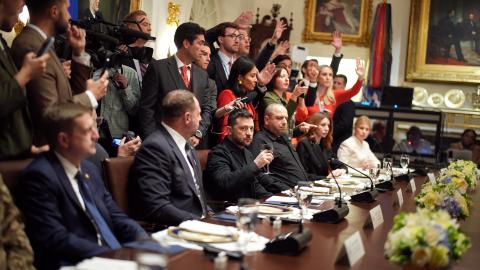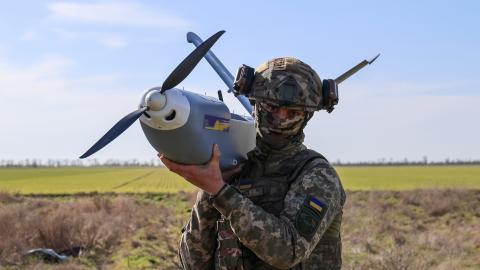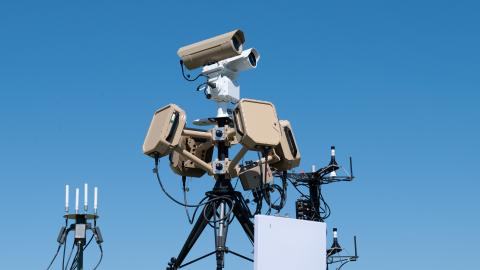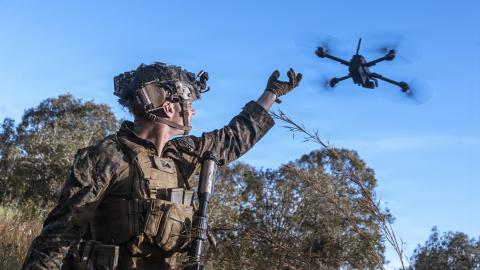The Russia-Ukraine War is not just a geopolitical earthquake—it is a tactical and technological inflection point. While many initially focused on tanks and artillery, the war’s defining feature has become the mass deployment of cheap, disposable, and networked technologies—especially drones, loitering munitions, and small-scale electromagnetic warfare systems.
In Ukraine, we are witnessing an Uberization of warfare—the use of low-cost, on-demand, and ubiquitous weaponry—alongside the dawn of the robotization of war. In World War II, Germany introduced the concept of blitzkrieg, combining new equipment with the idea of mobile warfare. Today, drone swarms—capable of saturation, connectivity, real-time surveillance, and precision targeting—are not only a tactical revolution, but also a profound disruption of operational art, much like blitzkrieg once was. Moreover, a major shift in the acquisition and technology-development processes made this tactical revolution possible. This revolution—sometimes called a crowdfunding war—should be both a wake-up call for those in charge of defense procurements and a call for a revolution in military affairs.
Yet questions remain about the true strategic impact of drone warfare. Indeed, the rapid development of counter-drone measures raises doubts about the long-term dominance of aerial drones as a decisive tool in future conflicts.1
Land, Sea, and Aerial Drones in Ukraine
On land, both militaries increasingly use wheeled and tracked ground drones for logistical tasks such as delivering supplies, transporting spare parts, and evacuating people who are wounded.2 A handful of armed variants exist, but their operational impact remains marginal. Their effectiveness is constrained by the difficulty of navigating rough and uneven terrain near front lines and by their high vulnerability to aerial drones, which dominate the battlefield and can easily detect and neutralize them.
At sea, Ukraine employs naval drones, which are primarily kamikaze surface and underwater drones equipped with anti-ship missiles. Kyiv no longer has a conventional navy—Russia destroyed its entire fleet in 2022—but it has nevertheless succeeded in pushing the Russian navy out of the western part of the Black Sea. The Russian fleet has lost around 20 vessels as a result. These low-cost naval drone systems, which can bypass traditional naval defenses, have proven to be an effective asymmetric tool in contested waters.
In the air, these systems have undergone their most significant and spectacular developments, reshaping tactics on both sides. Three main categories of drones are currently operating on the Ukrainian battlefield:
1. Medium-altitude long-endurance (MALE) drones
MALE drones—primarily the Bayraktar TB2—had their moment of glory at the beginning of the conflict when they could destroy armored columns. Today, however, they have been largely relegated to surveillance missions over the Black Sea, as they are highly vulnerable to Russian air defenses.
2. One-way attack (OWA) drones and pre-programmed loitering munitions
Both militaries mainly use these long-range suicide drones, designed to strike deep into enemy territory, often hundreds of kilometers away, to target infrastructure. These systems function as low-cost cruise missiles, and the most emblematic—and notorious—is the Iranian Shahed, which Russia and Iran manufacture at a joint plant in Yelabuga, Tatarstan. The Ukrainians use several types of longe-range OWA drones of their own, including the Liutyi. Yet these drones are not particularly sophisticated, and their warheads are relatively small. They are ineffective against hardened infrastructure, slow, and vulnerable to air defenses. Between 70 and 90 percent are intercepted and destroyed in flight. Their real strength lies in their numbers and volume—they overwhelm defenses through mass deployment.
3. Mini and micro tactical drones
These weigh less than 150 kilograms (roughly 330 pounds)—in many cases less than 25 kilograms (55 pounds)—and they typically have a range of around 15 kilometers (9 miles). The militaries use them in a wide variety of missions, particularly for reconnaissance. These drones are now omnipresent along the front lines for close-contact operations, making it nearly impossible for troops or equipment to remain hidden. They provide real-time intelligence, target acquisition, and battlefield awareness at the tactical level. They are also used in kinetic roles and are equipped with explosive charges. This includes bomber drones and first-person-view (FPV) kamikaze drones, which pilots operate while wearing virtual reality headsets. These systems were central to Ukraine’s Operation Spiderweb, a coordinated drone strike against Russian air force bases and facilities.
Other drone variants have also emerged, expanding the scope of battlefield applications:
- Dragon drones, which have flamethrowers
- Mother drones, which (like Russian nesting dolls) can carry and deploy FPV drones or act as radar relays
- Mine-laying drones and mine-hunting drones
The number of use cases continues to multiply along with the sheer volume of drones deployed on the battlefield. An estimated 10,000 drones per day are now being used.
A Tactical Warfare Revolution
Since February 2022, the conflict in Ukraine has served as a vast laboratory for the use of drones on a high-intensity battlefield. Within months, these systems became indispensable, reshaping doctrines, saturating defenses, and driving a permanent technological war of attrition.
Three Phases of Drone Development
The first phase of drone development, in 2022, was mass deployment. Ukraine launched its Army of Drones program through crowdfunding, which distributed unmanned aerial vehicles (UAVs) down to the company level and trained thousands of operators. The drone quickly became a tactical survival tool, used for reconnaissance and artillery fire adjustment.
Russia, initially more reluctant, later developed parallel networks. In the early stages, it relied almost exclusively on heavy military drones such as the Forpost3 and Orion.4 Russian doctrine, shaped by Western concepts, focused on achieving air superiority through a centralized combination of intelligence, surveillance, and reconnaissance (ISR) and deep strikes designed to saturate the theater of operations.
However, this approach revealed significant weaknesses. By concentrating drones within specialized units and keeping them largely disconnected from battalions and frontline formations, Russia created a rigid, top-down system. This lack of integration reduced reactivity, limited tactical flexibility, and exposed the entire structure to vulnerabilities—particularly when faced with more agile, decentralized, and adaptive models of drone warfare.
The second phase, between 2022 and 2023, saw the rise of strikes and counterstrikes. Both sides strengthened their air and electromagnetic defenses, leading to massive attrition of drone fleets. MALE drones virtually disappeared from the tactical battlefield, and kamikaze systems and loitering munitions—such as Russia’s Lancets or the Iranian Shaheds, which were deployed in swarms—began to dominate. The battlefield became a saturated space where a drone’s lifespan was measured in flights. During this phase, both sides steadily increased their use of drones, with Ukraine losing roughly 10,000 per month by mid-2023.5 In line with the Soviet doctrine of deep strikes, these drones were launched in massive waves, often alongside highly capable cruise missiles, including hypersonic missiles. Cheap drones overwhelm air defenses so that more advanced missiles can more easily hit their targets.
Finally, from 2023 onward, FPV drones became the new standard for Ukraine. Comparable to miniature anti-tank missiles, they have been produced by the tens of thousands each month. Ukraine integrated them into assault brigades with dedicated UAV companies. As a result, the battlefield has become highly transparent to a depth of 10–20 kilometers (about 6–12 miles). The FPVs’ effectiveness against troop concentrations and heavy vehicles is remarkable despite jamming and the massive need for trained operators. In some Ukrainian units, up to 60 percent of assets deployed in assaults now consist of drones.6
Each of these phases was defined by a relentless contest of innovation and countermeasures.
An Extremely Low-Cost Force Multiplier with Massive Tactical and Operational Impact
Drones have been successful in Ukraine largely because of their remarkable cost-effectiveness. However, costs vary dramatically by category—from a few hundred dollars for improvised FPV and consumer quadcopters, to tens of thousands for purpose-built loitering munitions like the Lancet, and millions for large MALE or high-altitude long-range (HALE) drones or other weaponized systems. Yet the vast majority of drones used in Ukraine fall at the very low end of this spectrum: €300–€5,000 ($350–$5,800) per unit. This low cost is precisely what makes them strategic—they provide a technological effect delivered at minimal cost, and are deployable at massive scale.
Initially, Ukraine relied on commercial off-the-shelf drones (primarily Chinese DJI models) and components. Yet it rapidly developed a domestic production base, integrating technologies drawn from everyday consumer electronics, such as smartphones, with genuine military capabilities in navigation, communication, and autonomy. Crowdfunding on the United24 platform makes this production possible.7
The rapid proliferation of low-cost, easy-to-produce drones—most notably loitering munitions such as Iran’s Shahed-136—has become a force multiplier that fundamentally reshapes the battlefield. These platforms provide affordable, continuous real-time surveillance over extended periods, allowing commanders to maintain situational awareness at scales previously possible only with far more expensive systems. At the same time, they confer asymmetric strike capabilities that are accessible to resource-limited states and non-state actors alike, so precision attacks become easier to launch. Swarm tactics can overwhelm conventional air defenses: massed, inexpensive drones saturate sensors and interceptors, forcing adversaries to take costly and complex countermeasures or accept persistent vulnerability. In short, cheap drones marry technological utility with sheer quantity, changing the calculus of both reconnaissance and strike in modern conflict.
This saturation effect is operationally transformative. Swarms of low-cost drones overwhelm radar and interceptors, draining high-value air-defense ammunition and imposing disproportionate costs on the defender. In many sectors of the front, tanks and armored vehicles have ceased maneuvering altogether, remaining concealed or dug in to avoid instant detection and destruction. Today, drones are responsible for up to 75 percent of combat losses on both the Russian and Ukrainian sides.8 These systems have not replaced traditional airpower, but they have profoundly disrupted the conduct of ground combat.
Today, Ukraine’s drone ecosystem has become a powerful engine of innovation,9 bringing together young soldiers and tech “geeks,” more than 300 startups dedicated to drone development, and a philosophy rooted in an economy of means and rapid responsiveness to frontline demands.
Drones are designed to meet real, immediate operational requirements, with design loops often completed in a matter of days or weeks—not months. There are no excessive technical specifications, no long procurement cycles, and typically no maintenance plans. Drones are treated like ammunition: single-use, expendable, and entirely focused on delivering a specific effect at a specific time. Each month, 200,000 are delivered to Ukrainian troops—up from 20,000 a month in 2024. Looking ahead, Ukraine can produce more than 4 million drones annually—an industrial mobilization effort that signals just how central unmanned systems have become to modern warfare.10
The Cognitive Dimension of Drone Warfare
Beyond their tactical utility, drones exert a disproportionate influence in the realm of cognitive warfare—shaping perceptions, morale, and decision-making at both the military and political levels. Their ubiquity and unpredictability create a sense of constant exposure: no place, from the front lines to rear areas, is entirely safe. This psychological saturation erodes soldiers’ endurance, instills fear in civilian populations, and forces adversaries to divert disproportionate resources to defense.
Attacks using so-called spiderweb tactics—swarms of small, networked drones that surround and harass enemy positions—illustrate how drones can immobilize troops not just physically, but mentally, creating the impression of trapping them in an inescapable net. The audacity of such attacks—like Israel’s beeper attacks—demonstrates that no part of a nation’s territory is a sanctuary. They underscore the vulnerability of open-air air force bases, which are exposed targets in an era of precision strikes and low-cost drone incursions. Likewise, the recent drone strike against Poland,11 though limited in scale, had an outsized psychological and political effect, demonstrating the permeability of the North Atlantic Treaty Organization’s borders. This event also showed that low-cost systems could trigger debates about escalation, deterrence, and alliance credibility. So while the physical damage was minor, the cognitive impact was major.
This development highlights an important paradox. While drones have not yet achieved strategic disruption in the Clausewitzian sense (they do not decide wars or redefine their political logic—see below), they do play a strategically significant cognitive role. By amplifying uncertainty, weaponizing viral imagery, and challenging perceptions of security, drones shape the information environment in ways disproportionate to their material power.
In that sense, drones may be comparable to airpower in its earliest psychological form—when bombers were valued as much for their ability to terrorize cities as for their actual destructive capacity. Drone warfare thus straddles the line: tactically revolutionary, strategically bounded, but cognitively destabilizing.
Toward an Algorithmic War of Attrition
Increasingly, militaries are integrating drones with artificial intelligence, especially to guide them automatically during the terminal flight phase when they approach their target—a phase highly vulnerable to electromagnetic jamming. These developments mark early steps toward drone autonomy and, more significantly, the rise of low-cost battlefield robotization. The Ukrainian command, constrained by limited human resources, has been compelled to advance autonomous systems. The Saker Scout drone, developed by a Ukrainian startup, exemplifies this evolution: It identifies targets and thermal signatures, though it does not initiate strikes independently. Other platforms go further, integrating autonomous navigation with final guidance, achieving strike success rates of 70–80 percent.12
The dronization of warfare requires militaries to rethink of command-and-control (C2) chains. Indeed, drones’ capabilities are quickly outpacing the capacity of traditional C2 chains. As the number and pace of precision strikes and ISR tasks grow, conventional human-led C2 becomes a bottleneck. Modern drone warfare will therefore force a shift: C2 architectures will need to embed AI technologies to manage sensing, targeting prioritization, tasking, deconfliction, and maneuvering at machine speed—while preserving appropriate human authority and legal accountability. Dronization demands a faster, more distributed, and more autonomous C2 than legacy chains—but it should still have human accountability. The practical path combines sensor fusion, AI decision-support, resilient communications, strong cybersecurity, and explicit legal and ethical guardrails. Done right, AI enables commanders to manage scale and pace while retaining control over the most consequential decisions; done wrong, it risks brittle automation, unintended escalation, and legal exposure.
What matters most, however, is how quickly an adversary adapts.
The Strategic Dimension of Drone Warfare, or Lack Thereof
Traditionally, the operational art depended on a clear chain: strategy set objectives, operational planning structured campaigns, and tactics delivered battles. With drones, tactical actors (small units or even individuals) now have operational reach. A drone team can strike logistics nodes 50 kilometers (31 miles) behind the front, blurring the boundary between tactical action and operational effect. Drones have transformed the operational art by reshaping the way operations are conceived and executed: eroding surprise, collapsing depth, flattening hierarchies, and accelerating the tempo. They make the operational environment more transparent, more saturated, and more fluid than ever before—but stop short of rewriting strategy itself. So far, drones have not altered the fundamental political nature of war—Clausewitzian theory still applies. They have not replaced the need for territorial control, nor have they eliminated the centrality of manpower, logistics, and morale. In Ukraine, despite their massive tactical impact—enabling real-time surveillance, precision strikes, and unprecedented saturation of the battlefield—drones have not decisively shifted the overall course of the war. Neither side has gained a strategic breakthrough solely through their use.
This situation highlights a crucial distinction: drones are a tactical revolution but are not yet a strategic disruption. They enhance lethality, amplify firepower, extend reach, expand situational awareness, and accelerate the pace of operations, but they do not by themselves deliver victory or alter the balance of power. Their effects remain bound by traditional strategic imperatives: holding ground, sustaining forces, and breaking the enemy’s will.
Historical parallels make the limits clearer. Blitzkrieg in World War II fundamentally changed how militaries fought wars by combining speed, mechanization, and airpower into an integrated strategy that reshaped entire campaigns, the balance of power. Nuclear weapons redefined the very logic of conflict by introducing deterrence on a global scale, changing not just tactics but also the structure of international relations itself. Drones, by contrast, have not reached this level of transformation. Their effects remain confined within existing strategic frameworks: wars are still decided by territory, industrial capacity, alliances, and ultimately political will.
Furthermore, the rapid emergence of counter-drone measures underscores their limitations. Just as armor led to anti-tank weapons and aircraft spurred air defenses, drones are already being met with electromagnetic warfare, jamming, and intercept systems. Far from being a decisive revolution, drone warfare appears to be part of the iterative cycle of innovation and adaptation that has always characterized military history.
Vulnerabilities and a Constant Race Against Obsolescence
The pace of innovation and counter-innovation is so rapid that any operational advantage can be eroded within weeks. A military therefore has to continuously update its platforms, or they will otherwise become irrelevant. In practice, adaptability—in software, tactics, and production—matters more than sheer numbers. So drone warfare is less a competition over who can develop a one-time technological breakthrough, and is more about who can perpetually upgrade and update the fastest.
Drones quickly become obsolete.
The adaptation cycle between offense (the sword) and defense (the shield) is extremely short—militaries can often develop effective countermeasures in mere weeks. This constrains the long-term dominance of drones, ensuring that they remain a tool that is powerful—yet not transformative at the strategic level.
New counter-drone defense systems are rapidly being developed, such as Russia’s Repellent-1 or Israel’s Iron Beam, which use lasers and jamming technologies. To remain operationally relevant, drones have to constantly evolve. Most are modular systems, with airframes that change very little over time. The real innovation—and vulnerability—lies in their software. Every four to six weeks, updates are required across critical systems—communication protocols, navigation systems, and flight control algorithms—to stay ahead of evolving electromagnetic warfare tactics, including jamming and signal interference.
Most drones are vulnerable to jamming.
Drones are still remotely piloted and have very limited autonomy. Claims about fully autonomous drones like the Russian Lancet-3 or Ukrainian Saker Scout are exaggerated. Ukrainian developers have created object recognition and terminal guidance technologies, but these tools are currently limited in complexity and trustworthiness. Tethered drones are less susceptible to electromagnetic warfare as their wired connection shields them from jamming and interference, but this technique presents other vulnerabilities.
In this sense, drone warfare is a continuous software arms race where agility, not just quantity, determines success.
Drones involve production and scaling challenges.
Ukraine’s drone innovation has been largely startup-driven and artisanal, whereas Russia has moved to industrial production. Although Ukraine often fields more advanced and better-performing systems, it risks being overwhelmed by Russia’s sheer manufacturing capacity.
Maintaining an edge in drone warfare requires investment not only in software development—artificial intelligence, autonomy, and communication systems—but also in industrial-scale production. Yet mass production alone is not enough. For drones to remain effective, manufacturing needs to stay flexible and adaptive, continuously evolving in response to changing battlefield conditions and the rapid development of counter-drone measures. The future of drone warfare will be determined not just by innovation at the design stage, but by the ability to scale, adapt, and sustain production at an industrial level.
Drone warfare presents human resource challenges.
Drone warfare is not just about producing drones—it is also about producing the people who can operate them effectively, at scale, and through constant technological change. This may prove as decisive as industrial capacity in shaping who holds the long-term advantage.
The need for numerous operators presents a major constraint on drone warfare. Unlike many other weapons systems, many drones—especially commercial quadcopters adapted for military use—require individual operators for piloting, targeting, and coordination. Training a single operator takes from three to four weeks, which may seem modest, but when scaled across thousands of systems, the burden on manpower and training infrastructure becomes significant.
Because drones need human operators, several challenges emerge:
- High demand for operators. The proliferation of drones means that armies need large numbers of trained personnel. Each destroyed or lost drone requires not just hardware replacement but also the reallocation of trained operators.
- Skill retention and turnover. Many drone operators come from civilian or volunteer backgrounds (e.g., gamers, hobbyists, engineers). While this brings innovation and agility, it also leads to issues of retention, burnout, or rotation back into civilian life. Maintaining a consistent, professionalized cadre is resource intensive.
- Cognitive and psychological load. Operating drones is mentally taxing. Constant surveillance, real-time decision-making, and remote lethality blur the lines between combatant and observer. Operators may be physically distant from the battlefield, but psychologically they remain deeply exposed, contributing to fatigue and stress.
- Training vs. innovation gap. Rapid technological evolution means that operators must continuously adapt to new systems, software updates, and countermeasure environments. A four-week training cycle is only the baseline; sustaining competence requires ongoing education, which further strains resources.
- Organizational integration. In countries like Ukraine, where drone innovation is highly decentralized, training and integrating thousands of new operators from startups, volunteer groups, and the military create a coordination challenge. In Russia’s more centralized model, the rigidity of doctrine slows training adaptation, limiting operator effectiveness.
Implications for Western Militaries
Drones have transformed modern warfare, making rapid integration, adaptability, and scalable innovation as crucial as platform sophistication and firepower. Therefore, Western militaries need to learn from the Russia-Ukraine War and rethink doctrines, operational models, and force development.
Addressing the Challenges of This New Warfare
In Ukraine, we are witnessing the rise of mass-produced, technologically capable systems at an affordable price. This symbolizes the reconciliation of two concepts once thought contradictory: mass and technology.
Drones have redefined ground tactics, creating battlefield transparency, saturating defenses, and paralyzing large-scale maneuvers. In an order of the day.13 issued on April 23, 2025, French Chief of Staff General Pierre Schill called on the cavalry to reinvent itself. Praising its historic power, he recalled that it has long been the arm that unbalances the enemy and whose intervention secures victory. Yet the advent of drone warfare has relativized the strength of armored forces, with fronts increasingly static and maneuvers slowed. A growing gap is emerging between the costly sophistication of combat vehicles and the inexpensive, rugged means available to destroy them.
Western militaries thus need to decide: Should drones remain limited to optimizing existing forces, or should they be integrated as an organic tool of maneuver, as in Ukraine?
The latter path demands a profound transformation: an agile civil-military model; rapid innovation cycles embracing not only tech innovation but also new doctrine based on a multi-domain approach integrating the effects of drones; and an army capable of absorbing large numbers of reservists and operators.
Without such a transformation, Western technological superiority could quickly become a weakness when confronted by adversaries capable of flooding the skies with cheap, disposable swarms. Responding requires a paradigm shift: instead of investing in rare, exquisite platforms, belligerents are betting on “cheap, fast, many.”
The Need for an Industrial Revolution
The Russia-Ukraine War shows the need for speed in the adaptation cycle. Every innovation almost immediately triggers a countermeasure. The battlefield has become a space of permanent research and development, where superiority is measured by the ability to innovate and produce at scale not only drones but also counter-drone systems. The conflict has triggered a race among nations to adapt their defense industries for large-scale drone production, battlefield integration, and counter-drone measures. The United States,14 Turkey, and Israel—not to mention China, which was already the largest producer of commercial drones—have developed supply chains and production capabilities tailored to meet this new demand.
The war in Ukraine has exposed long-recognized weaknesses that militaries have ignored, which raises multiple issues. How relevant are current Western capabilities and programs in light of the rapid evolution of drone warfare? Can traditional defense planning cycles keep pace with the tempo of innovation emerging from the field?
In France, for example, armament processes remain slow and overly centralized, shaped by an industrial logic based on long timelines. They are also often burdened with unrealistic requirements concerning French control of components, software, and digital transformation, or by the complexity of European partnerships. Acquisition mechanisms are equally rigid, and until recently, actors outside the traditional defense industrial base were not considered as suppliers.
For years, France treated drone programs as conventional programs and required heavy specifications that constrained agility, rapid innovation, and field experimentation. Moreover, France faces a delay of nearly 15 years in combat drone development due to an operational culture that prioritizes human control over firepower and manned airpower, often at the expense of adapting to new paradigms. Despite its delay, France has now entered the drone race with two priorities: (1) developing effective protection against hostile systems and (2) fostering startup creativity to build drone capabilities. This shift, anchored in a targeted €5 billion ($5.8 billion) investment, reflects both an acknowledgment of strategic vulnerabilities and a determination to stimulate innovation. The policy has unleashed a surge of initiatives. The French Army’s Future Combat Command has launched an ambitious equipment plan that includes the creation of drone pilot schools, while the Defense Airborne Drone Pact seeks to structure a low-cost drone industrial base—drawing not only on traditional defense players but also on civilian industries such as the automotive sector.
The Russia-Ukraine War shows that Western militaries need nothing less than an industrial revolution in armaments.15 They should invest in the modular, open-source, rapid manufacturing of drone and counter-drone technology, while also accelerating traditional procurement cycles. This transformation should rest on three complementary pillars:
1. Creativity and Experimentation
- Encourage rapid prototyping, field testing, and integration of civilian technologies.
- Foster innovation ecosystems that connect startups, engineers, and frontline operators.
- Embrace a culture of iterative design in which failure accelerates adaptation rather than hindering it.
2. Mass Industrial Production
- Shift from artisanal or startup-driven approaches to large-scale manufacturing capacity.
- Secure supply chains for critical components and raw materials to ensure continuity under pressure.
- Invest in modular designs that can be mass-produced while allowing upgrades.
3. Flexibility and Adaptability
- Build industrial processes that can pivot rapidly in response to new threats or countermeasures.
- Shorten acquisition cycles to match the pace of battlefield innovation.
- Maintain a balance between standardized platforms and the ability to integrate new payloads, software, and tactics.
What is at stake is not simply catching up, but redefining the balance between protection, innovation, and industrial scalability in a domain where agility and mass production increasingly determine operational superiority.
Only by reconciling creativity, scale, and flexibility can states sustain technological and operational superiority in future wars. The revolution in armaments is not merely about producing more but about producing smarter and faster while remaining resilient to the relentless pace of innovation.
Beyond Drones: Toward a Doctrinal Revolution
Drones alone are not transforming the battlefield. Instead, they are disrupting the battlefield by working with other weapon systems as a networked whole. For example, both Russia and Ukraine have paired unarmed drones with artillery, which dramatically accelerates targeting timelines and enables responsive, precise, ground-based fires. Drones have become the critical link in what Russia calls its reconnaissance-strike complex—the network that acquires, processes, and transmits targeting data to artillery units.
Because artillery remains the decisive weapon of this war, drones have assumed a vital enabling role as spotters, identifying targets and adjusting fires by feeding data through virtual battle networks, such as Kropyva and Strelets. Increasingly, this role is carried out not by a single drone but by stacks of drones operating in the same airspace, each with distinct functions. The result is a highly distributed, resilient kill chain—driven by a decentralized and agile C2, which is far harder to disrupt.
This evolution highlights the need for a doctrinal revolution, not just new technology
From the three Ds to air and information superiority. Once defined as handling “dirty, dull, dangerous” tasks, drones now reshape the very meaning of airpower. Air superiority is no longer only about jets and helicopters; it is also about achieving drone superiority—outmatching the adversary in numbers, resilience, and electromagnetic warfare dominance.
From kill chains to kill webs. Rigid, linear targeting models are insufficient against an adaptive, contested environment. The future lies in kill web architectures—decentralized, data-driven, and resilient to attrition—that are capable of integrating drones seamlessly with ground fires, electromagnetic warfare, cyber operations, and space-based assets.
Rethinking defense. Traditional air defense systems were never designed to counter mass drone swarms. Ukraine and its allies have had to improvise, combining electromagnetic jamming, AI-assisted targeting, and layered interception strategies. These adaptations point to the urgent need for multi-domain defense doctrines that integrate drones not as adjuncts but as central actors.
Drones are forcing militaries to move from platform-centric to network-centric warfare, multi-domain operations in which adaptability, integration, and resilience matter as much as firepower itself. On the conceptual level, the French armed forces have launched several exploratory efforts—one focused on drone swarms and another on deep-strike operations—and have reflected more broadly on the robotization of the battlefield. These initiatives reflect a growing recognition that drones are not merely tactical enablers but drivers of doctrinal and operational change.
Still Pending Questions and New Political-Strategic Dilemmas
Even as drones reshape the operational art of war, fundamental questions remain unresolved:
Responsibility. Who is accountable in the event of mishaps, accidents, or unintended autonomous attacks?
Thresholds for force. Does the ability to strike without immediate political risk lower the threshold for the use of force?
The doctrinal gap. Traditional militaries are still lagging in formulating doctrines for the mass deployment of drones, leaving a gap between theory in staff colleges and practice on the battlefield.
Ethical and trust questions. While the reality of AI on the battlefield is still far removed from the scenarios imagined in Terminator or Black Mirror, key debates center on maintaining human control and ensuring accountability. Building trust in AI technologies also presents major challenges, from the integrity of data and algorithms to the growing exposure of these systems to cyber threats.
The future of drones. Are drones truly the future of warfare, or merely a transitional phase? The development of sophisticated countermeasures—electromagnetic warfare, directed-energy weapons, and systems like Iron Beam—could eventually render the air drone obsolete.
Conclusion: Between Innovation and Obsolescence
Drone warfare may or may not represent the future of combat, but it is undeniably the reality of today’s wars and a pressing challenge to national security. Ignoring its doctrinal implications risks repeating the mistakes made with tanks after World War I—focusing narrowly on platforms while failing to grasp their revolutionary impact on operational art. Therefore, the strategic question is not over whether drones will last, but on two other issues. First, how can militaries harness their disruptive potential, adapt to their vulnerabilities, and integrate them into a truly multi-domain doctrine that is resilient to technological change? Second, how can procurement agencies create a new ecosystem able to face the challenges of this new industrial revolution and the expectations of soldiers in the field?
Drone warfare may or may not be a revolution in military affairs, but it certainly offers a strong reminder: true revolutions lie not in the platform itself, but in the doctrines, organizations, and military and industrial strategies that integrate it. Whether drones become the future of war or only a passing phase, the challenge is to transform their tactical disruption into lasting operational and strategic effect.















